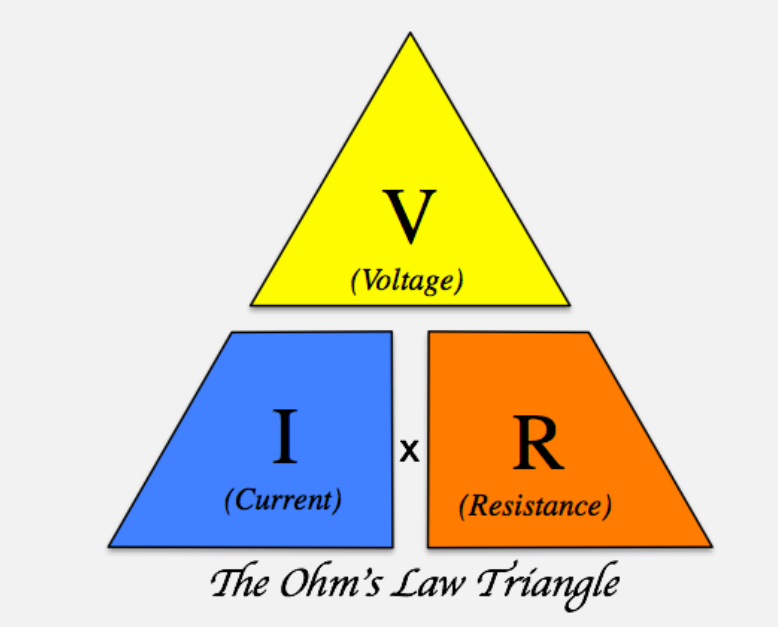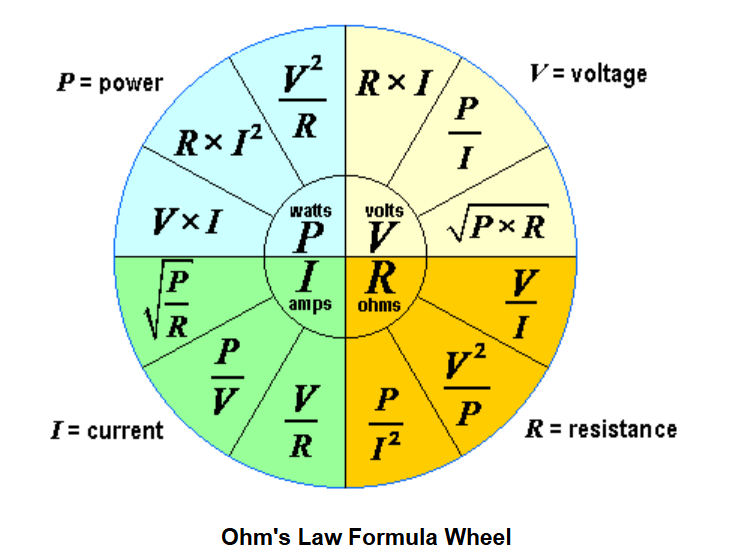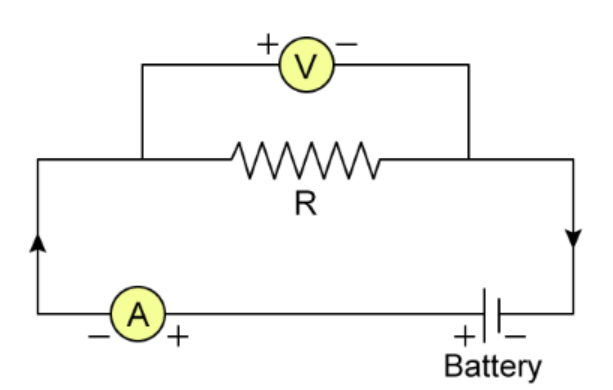Ohm's Law Calculator – Solve for Voltage, Current, Resistance & Power
Please provide any 2 values and click "Calculate" to get the other values in the ohm's law equations V = I × R and P = V × I.

Calculation Results
Voltage
Current
Resistance
Power
Ohm's Law Formulas
Voltage
Current
Resistance
Power
Ohm's Law Diagrams



Understanding Ohm's Law
Voltage (V)
Voltage represents the electrical potential difference between two points. It's what pushes electric current through a circuit. Think of it as the "pressure" in an electrical system.
Current (I)
Current is the rate of flow of electric charge. It's measured in amperes (A). A higher current means more electrons are moving through the circuit per second.
Resistance (R)
Resistance limits current flow. It depends on material type, cross-sectional area, length, and temperature. Conductors like copper have low resistance, while insulators have high resistance.
Power (P)
Power indicates how much energy is used or converted per second. Devices like bulbs, resistors, and motors consume or dissipate power in watts.
Test Your Ohm's Law Knowledge
Answer: 0.03 A
To find the current flowing through the LED, we use Ohm's Law: I = V / R
This means 0.03 amperes (or 30 milliamperes) of current flows through the LED circuit.

Answer: 2.00 A
To find the current output of the phone charger, we use Ohm's Law: I = V / R
The phone charger outputs 2.00 amperes of current to the device.

Answer: 4.00 Ω
To find the resistance of the car speaker, we rearrange Ohm's Law: R = V / I
The car speaker has a resistance of 4.00 ohms.

Answer: 250.00 Ω
To find the resistance needed to limit current, we rearrange Ohm's Law: R = V / I
You should use a 250.00 ohm resistor to limit the current to 0.02A in the LED circuit.

Answer: 6.00 Ω
To find the resistance of the load, we rearrange Ohm's Law: R = V / I
The load connected to the AA battery has a resistance of 6.00 ohms.

Answer: 12.50 A
To find the current drawn by the electric heater, we use the power formula: I = P / V
The electric heater draws 12.50 amperes of current from the 120V power source.

Answer: 19.20 W, Yes
To find the power rating of the device, we use the power formula: P = V × I
The device has a power rating of 19.20 watts. Since the device draws 0.8A of current, a 1A fuse would be sufficient as it provides a safety margin.

Answer: 10.00 W
To find the power being transferred from the power bank to the phone, we use the power formula: P = V × I
The power bank is transferring 10.00 watts of power to the phone.

Answer: 3.00 Ω, 48.00 W
To find the resistance of the bulb, we rearrange Ohm's Law: R = V / I
To find the power used by the bulb, we use the power formula: P = V × I
The car headlight has a resistance of 3.00 ohms and uses 48.00 watts of power.

Answer: 1.33 Ω
To find the resistance of the wire, we rearrange Ohm's Law: R = V / I
The wire has a resistance of 1.33 ohms.

Ohm's Law Calculator – Voltage, Current, Resistance & Power Made Easy
Introduction
The Ohm's Law Calculator is a must-have tool for anyone working with electricity or electronics. Whether you're an engineer, student, technician, or DIY hobbyist, understanding the relationship between voltage (V), current (I), resistance (R), and power (P) is fundamental. This calculator simplifies those equations instantly — no manual formulas or unit conversions required.
Ohm's Law forms the foundation of all electrical and electronic systems. It describes how electrical current flows through a conductor when voltage and resistance are known. By using our online Ohm's Law Calculator, you can find missing electrical values instantly and accurately.
What Is Ohm's Law?
Ohm's Law defines the relationship between voltage, current, and resistance:
V = I × R
Where:
- V = Voltage (Volts)
- I = Current (Amperes or Amps)
- R = Resistance (Ohms, Ω)
This simple equation means that voltage is the product of current and resistance. It can also be rearranged to solve for any missing value:
- Current: I = V / R
- Resistance: R = V / I
Our Ohm's Law Calculator lets you compute all of these instantly, plus power, using the additional formula:
P = V × I
How the Ohm's Law Calculator Works
Using the calculator is easy. Simply enter any two known values — such as voltage and resistance — and the tool automatically computes the remaining variables.
Supported Calculations:
- Voltage (V) – Calculate voltage when current and resistance are known.
- Current (I) – Find the flow of electrical charge through a circuit.
- Resistance (R) – Determine how much a component resists the current.
- Power (P) – Compute power dissipation in watts using P = V × I.
You can also switch between units such as volts, millivolts, amps, milliamps, ohms, kilohms, watts, or milliwatts — making it ideal for both low-power electronics and high-voltage applications.
Ohm's Law Formulas at a Glance
| Quantity | Formula | Unit | Description |
|---|---|---|---|
| Voltage | V = I × R | Volts (V) | Electrical potential difference |
| Current | I = V / R | Amps (A) | Flow of electric charge |
| Resistance | R = V / I | Ohms (Ω) | Opposition to current flow |
| Power | P = V × I | Watts (W) | Electrical energy per second |
The calculator performs all four calculations instantly based on the two values you provide.
Example Calculations
Example 1: Find Current
If you apply 12 V across a 4 Ω resistor:
I = V/R = 12/4 = 3A
The current through the resistor is 3 amperes.
Example 2: Find Resistance
A 24 V source delivers 6 A of current:
R = V/I = 24/6 = 4Ω
The circuit's resistance is 4 ohms.
Example 3: Find Power
For a 12 V circuit carrying 2 A:
P = V × I = 12 × 2 = 24W
The power consumed is 24 watts.
The Ohm's Law Calculator performs these instantly — saving time and reducing error.
Understanding the Four Variables
1. Voltage (V)
Voltage represents the electrical potential difference between two points. It's what pushes electric current through a circuit. Think of it as the "pressure" in an electrical system.
2. Current (I)
Current is the rate of flow of electric charge. It's measured in amperes (A). A higher current means more electrons are moving through the circuit per second.
3. Resistance (R)
Resistance limits current flow. It depends on material type, cross-sectional area, length, and temperature. Conductors like copper have low resistance, while insulators have high resistance.
4. Power (P)
Power indicates how much energy is used or converted per second. Devices like bulbs, resistors, and motors consume or dissipate power in watts.
Ohm's Law Triangle
A simple way to remember the relationships between voltage, current, and resistance is with the Ohm's Law Triangle:
V
--------
I R
Cover the quantity you want to calculate.
- For voltage: multiply I × R.
- For current: divide V ÷ R.
- For resistance: divide V ÷ I.
This visual helps beginners quickly recall formulas when designing or troubleshooting circuits.
Power Law & Extended Relationships
Ohm's Law and Power Law can be combined to form several useful equations:
- P = V × I
- P = I² × R
- P = V²/R
These allow you to calculate power even when voltage or current is unknown. The calculator automatically applies these relationships once you input any two parameters.
Applications of Ohm's Law
Ohm's Law isn't just theory — it applies everywhere electricity is used:
- Circuit design & testing – Engineers determine resistor values for LED circuits or voltage dividers.
- Troubleshooting electronics – Identify faulty components by measuring voltage and current.
- Battery testing – Estimate load and discharge rates.
- Home wiring – Calculate power loads and safety limits.
- Education & training – Teach electrical fundamentals visually and interactively.
A reliable Ohm's Law Calculator saves time, enhances accuracy, and helps prevent costly design errors.
Advantages of Using an Online Calculator
- Instant Results – No manual math or conversion errors.
- Multiple Unit Options – Choose volts, millivolts, amps, ohms, or kilowatts easily.
- Educational Value – Reinforces understanding of core electrical principles.
- Error-Free – Reduces human mistakes in computation.
- Mobile Friendly – Works on smartphones, tablets, or PCs anywhere.
Whether you're calculating LED resistors, power consumption, or testing current draw, this tool simplifies every task.
Tips for Accurate Results
- Enter consistent units (e.g., volts with ohms to find amps).
- Check for component tolerances — real values may vary slightly.
- Temperature changes can affect resistance; adjust if precision is critical.
- For AC circuits, Ohm's Law still applies but impedance (Z) replaces resistance (R).
- Always verify values before connecting circuits to power sources.
This tool is for educational use only. We recommend verifying the results before applying them.
